TL;DR
If your Scandinavian living room still isn’t hygge, focus on scale, lighting, layout, and texture. Start with the right rug size for a sectional sofa, replace builder grade light fixtures with warm 2700K lamps on dimmers, and float furniture to create 30–36 inch walkways. A pared-back palette, natural woods, and layered textiles will bring that soft, inviting, hygge decor you actually want.
Why Scandinavian style can miss the hygge mark
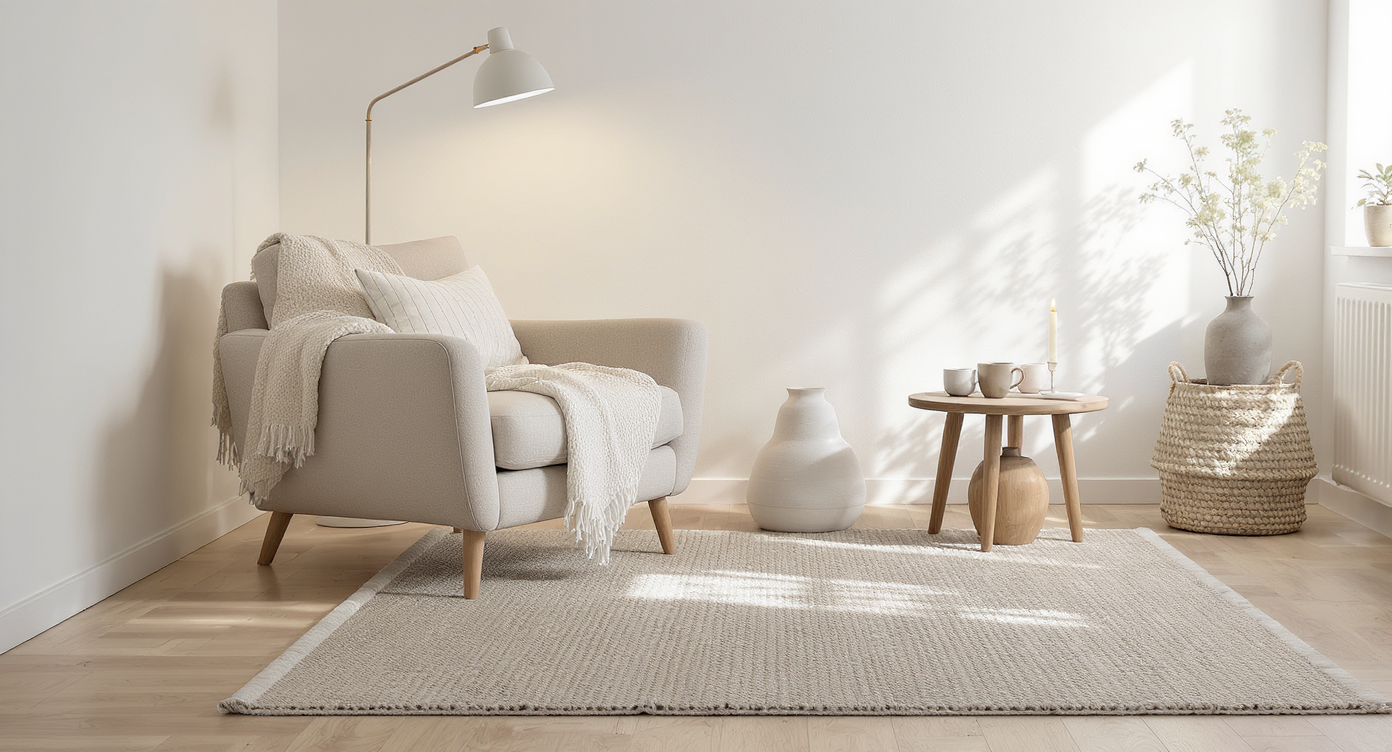
Small tweaks in lighting, layout, and texture bring hygge comfort to Scandinavian spaces.
Scandinavian design promises calm, clarity, and that hard-to-define Danish comfort known as hygge. But here’s the thing: even with an interior designer, rooms often stall at “minimal” and never arrive at “cozy.” If your living room and dining room look styled but feel thin, you’re not alone.
What usually goes wrong? Scale, light, and layout. A too-small rug, a sectional jammed into a corner, and overhead fixtures stuck at “builder grade” will drain warmth from otherwise beautiful pieces. The good news is you don’t need a full redo. With a few precise tweaks, you can turn a chilly showcase into a Scandinavian living room that actually feels hygge.
Suggested image alt text: "Calm Scandinavian living room with large wool rug, linen sofa floated off the wall, paper lantern pendant, and layered warm neutrals." Caption: "Hygge starts with scale, light, and texture."
Hygge decor starts with scale, light, and texture. Use these Scandinavian living room ideas to fix layout, rug size, and lighting fast.
The Fix: Scale, light, layout, and texture
Start with measurements, not moodboards.
Experts recommend 30–36 inch walkways, coffee tables 16–18 inches from the sofa, and chandeliers hung 30–36 inches above the dining table for comfortable, hygge-ready flow.
- Right-size the rug. For a sectional or sofa, choose 8×10 at minimum; 9×12 is ideal so all front legs sit on the rug. A too-small rug makes a room feel skimpy. Opt for wool, jute-wool blends, or flatweave in warm neutrals with subtle pattern; if your floors are dark, go richer than pastels (think oat, mushroom, greige, or a muted sage).
- Float the sectional (even a little). Pull seating 8–12 inches off the wall, or rotate to center on the focal point. Preserve a 30-inch path behind or beside the sofa so entrances aren’t blocked. If floating isn’t possible, consider swapping to a straight sofa plus a lounge chair when budget allows.
- Replace builder grade lighting. Hygge lighting is layered and warm. Use 2700K bulbs, add dimmers, and aim for 3–5 light sources per room: paper lantern or linen drum overhead, a floor lamp, two table lamps, and candles. Wood or linen accents nod to Scandinavian design without shouting.
- Edit styles for cohesion. Remove farmhouse-leaning pieces like leaning ladders and shabby mirrors if hygge is the goal. Choose light or mid-tone oak, ash, or birch frames; keep metals matte black or brass in small doses. A single, low credenza in the dining room beats open display ladders for a calm look.
- Layer natural texture. Think boucle throws, linen cushions, wool rugs, ceramic bowls, and woven baskets. Two or three chunky textures feel cozier than six small knick-knacks. Curtains should hang high and wide, kiss the floor, and use natural fibers.
- Lift the eye with art and plants. Hang art with the center at ~57 inches, and keep pieces large enough to earn the wall. Mix one big vintage-feel piece over the dining credenza or create a tight gallery over the sofa. Add one tall plant (fiddle leaf, olive, rubber tree) to introduce organic height.
- Dining details. In Scandinavian dining rooms, rugs are optional; if used, they should extend 24 inches beyond the table on all sides. Most achieve hygge with a bare floor, one generous artwork, a low vase with branches, and a pendant at 30–36 inches above the tabletop.
User insight: Many homeowners feel their room is “off” only to learn the rug is undersized and lights are too cool. Correct those two and the space softens immediately.
Anecdote
One couple I worked with swore their space was “too small” to float furniture. We taped a 9×12 rug outline, shifted the sofa 10 inches off the wall, and suddenly there was a natural path behind it. They added a paper pendant and two table lamps; that night, they texted a photo of their kids reading on the floor — first time ever.
Common mistakes that steal hygge (and easy course-corrections)
You can’t buy hygge if the basics are the wrong size.
Designers often advise fixing scale first — a larger rug and adjusted lighting do more than a dozen new accessories.
- Too-small rug. It visually shrinks the room. Solution: upgrade to 8×10 or 9×12 and tuck at least the front legs under the seating.
- Sectional shoved into a corner. It blocks flow and reads “cramped.” Solution: pull the sofa out 8–12 inches or reorient; maintain 30–36 inch paths.
- Builder grade light fixtures. They flatten the room. Solution: swap for paper, linen, or wood-accent pendants and add dimmers; stay at 2700K.
- Pastels fighting dark floors. Candy hues can feel nursery-like. Solution: move to warm neutrals, muted greens, rust, slate blue, and mid-tone woods.
- Art hung too high or too small. Walls feel bare. Solution: center at ~57 inches; go larger or build a tight grid/gallery to anchor the wall.
Pro tips designers use to dial up Scandinavian hygge
Think layers of light and touch, not layers of stuff.
For a true hygge mood, aim for five lighting layers max and edit decor to only what’s useful or truly loved.
- Light recipe. One pendant, one floor lamp, two table lamps, and candles. Use 2700K bulbs and dimmers to shift from task to ambient at night.
- Color strategy. Pick a core trio: warm white, mid-oak, and sage; or warm white, walnut, and slate blue. Repeat them across textiles, art, and accessories for cohesion.
- Mark before you buy. Tape rug footprints (8×10, 9×12) and walk the paths. If you can’t get a clean 30-inch walkway, reconsider layout before shopping.
- Mount the TV and hide the cords. Clean lines matter in Scandinavian design. A low, simple media unit and a wall-mounted TV calm the focal wall.
- Blend woods confidently. With darker floors, choose medium woods (oak, teak) rather than pale birch everywhere; contrast looks intentional and sophisticated.
Here’s a quiet truth: coziness is a feeling you build with light, softness, and rhythm — not a shopping list.
Real homes, real fixes: quick anecdotes
Small changes, big relief.
Homeowners routinely report that swapping lights, right-sizing rugs, and moving one oversized piece transformed “cold” rooms into cozy spaces.
- The sectional that blocked two doorways. The owners pulled it 10 inches off the wall, retired two nesting tables, and upgraded to a 9×12 wool rug. Result: 34-inch walkways and a room that finally breathed.
- Builder grade to paper pendant. A simple rice-paper lantern and two table lamps (under $200 total) made evenings glow warmly — no new furniture needed.
- The pastel rug problem. One family swapped a sorbet-colored rug for a muted sage flatweave and echoed that green in two linen pillows. The dark floors stopped fighting the palette.
- Dining room calm. Removing the rug, adding a low oak credenza, and hanging one oversized abstract at 57 inches delivered the pared-back, Scandinavian feel they wanted.
Visualization Scenario
Picture this: a 9×12 wool rug in oat anchors your sectional, now pulled slightly forward. A rice-paper pendant hovers like a soft moon; two table lamps pool gentle light on wood end tables. The TV is wall-mounted; cords disappear. A low oak credenza grounds the dining wall, an oversized abstract glows above it, and a single vase of olive branches nods to nature. The air feels slower. Feet find the rug. That’s hygge.
FAQ: quick answers for hygge decor and Scandinavian style
How do I make a living room feel hygge?
Prioritize warm, layered lighting (2700K bulbs on dimmers), a large wool rug that anchors seating, and natural textures like linen and wood. Edit decor to the essentials and create 30–36 inch walkways for easy, cozy flow.
What is the best rug size for a sectional sofa?
Designers often advise 8×10 as a minimum and 9×12 as ideal so all front legs sit on the rug. Square rooms can take an 8×8 or 9×9 if it fits the layout.
How high should I hang a chandelier over a dining table?
Hang pendants or chandeliers 30–36 inches above the tabletop, centered, and scale the fixture to roughly half to two-thirds the table width.
How do you replace builder grade light fixtures on a budget?
Choose paper lanterns, linen drums, or simple wood-accent pendants and add dimmers; many stylish fixtures cost under $150. Use warm 2700K bulbs for hygge decor.
Should a Scandinavian dining room have a rug?
It’s optional. Many Scandi dining rooms skip rugs; if you add one, allow 24 inches beyond the table on all sides so chairs slide easily.
Bring the room back to you
Hygge isn’t elusive — it’s measured. When the rug grounds the seating, light is warm and layered, paths are clear, and textures invite touch, a Scandinavian living room feels like home. Start with the big moves: scale, light, and layout. Then edit to what you love and let the room exhale.
Want to test arrangements and palettes before you lift a sofa? Try visualizing options with ReimagineHome and see your hygge plan come to life.
.svg)

.svg)


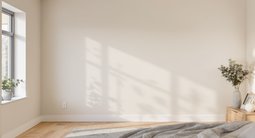
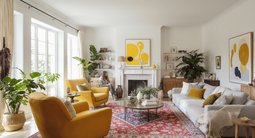


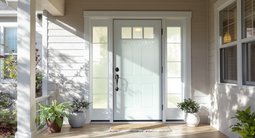

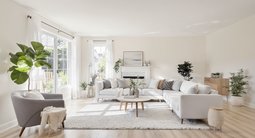

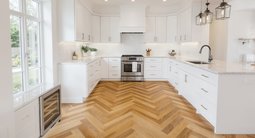



.png)